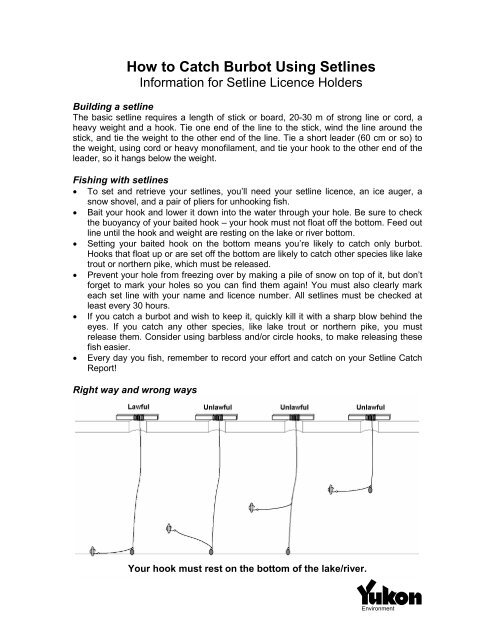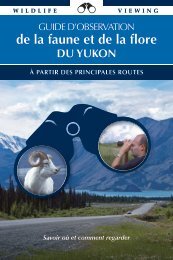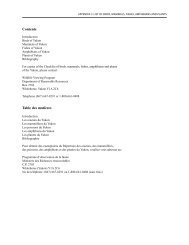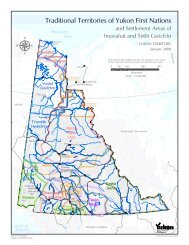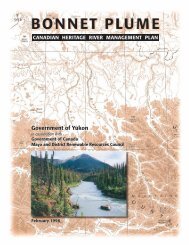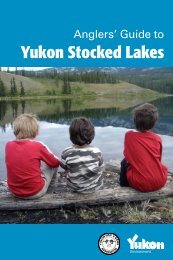How to Catch Burbot Using Setlines - Environment Yukon
How to Catch Burbot Using Setlines - Environment Yukon
How to Catch Burbot Using Setlines - Environment Yukon
You also want an ePaper? Increase the reach of your titles
YUMPU automatically turns print PDFs into web optimized ePapers that Google loves.
<strong>How</strong> <strong>to</strong> <strong>Catch</strong> <strong>Burbot</strong> <strong>Using</strong> <strong>Setlines</strong><br />
Information for Setline Licence Holders<br />
Building a setline<br />
The basic setline requires a length of stick or board, 20-30 m of strong line or cord, a<br />
heavy weight and a hook. Tie one end of the line <strong>to</strong> the stick, wind the line around the<br />
stick, and tie the weight <strong>to</strong> the other end of the line. Tie a short leader (60 cm or so) <strong>to</strong><br />
the weight, using cord or heavy monofilament, and tie your hook <strong>to</strong> the other end of the<br />
leader, so it hangs below the weight.<br />
Fishing with setlines<br />
• To set and retrieve your setlines, you’ll need your setline licence, an ice auger, a<br />
snow shovel, and a pair of pliers for unhooking fish.<br />
• Bait your hook and lower it down in<strong>to</strong> the water through your hole. Be sure <strong>to</strong> check<br />
the buoyancy of your baited hook – your hook must not float off the bot<strong>to</strong>m. Feed out<br />
line until the hook and weight are resting on the lake or river bot<strong>to</strong>m.<br />
• Setting your baited hook on the bot<strong>to</strong>m means you’re likely <strong>to</strong> catch only burbot.<br />
Hooks that float up or are set off the bot<strong>to</strong>m are likely <strong>to</strong> catch other species like lake<br />
trout or northern pike, which must be released.<br />
• Prevent your hole from freezing over by making a pile of snow on <strong>to</strong>p of it, but don’t<br />
forget <strong>to</strong> mark your holes so you can find them again! You must also clearly mark<br />
each set line with your name and licence number. All setlines must be checked at<br />
least every 30 hours.<br />
• If you catch a burbot and wish <strong>to</strong> keep it, quickly kill it with a sharp blow behind the<br />
eyes. If you catch any other species, like lake trout or northern pike, you must<br />
release them. Consider using barbless and/or circle hooks, <strong>to</strong> make releasing these<br />
fish easier.<br />
• Every day you fish, remember <strong>to</strong> record your effort and catch on your Setline <strong>Catch</strong><br />
Report!<br />
Right way and wrong ways<br />
Your hook must rest on the bot<strong>to</strong>m of the lake/river.
Tips for catching burbot<br />
• <strong>Burbot</strong> are most active at night and feed along the bot<strong>to</strong>ms of lakes and rivers.<br />
• The best spots <strong>to</strong> find burbot are shallow bays, shoals and near creek mouths with<br />
mud or sand bot<strong>to</strong>ms.<br />
• <strong>Burbot</strong> hunt mostly by smell, not sight, and are not spooked by heavy line – using<br />
heavy line reduces bycatch of other species, and is easier <strong>to</strong> handle while wearing<br />
gloves.<br />
• <strong>Burbot</strong> are attracted <strong>to</strong> a wide variety of bait – try frozen smelt, chicken livers, or<br />
even bacon!<br />
• Consider using circle hooks for setlines – they are designed <strong>to</strong> avoid deeply hooking<br />
fish.<br />
Circle hooks?<br />
Circle hooks differ from conventional J-style hooks in that the hook point is bent back<br />
<strong>to</strong>ward the hook shank. This design means that as a fish swims away with the bait in its<br />
mouth, the hook doesn’t set until it reaches the corner of their mouth, hooking them<br />
there rather than in the throat or s<strong>to</strong>mach. The curved-in point also makes it harder for<br />
fish <strong>to</strong> spit the hook, even with barbless circle hooks.<br />
Barbless<br />
J hook<br />
Barbed<br />
J hook<br />
In our experience, circle hooks are ideal for setlines. The best rig we have tested is a 2/0<br />
barbless circle hook on a 40lb test monofilament leader, tied using a knot such as a<br />
perfection loop or rapala knot, which allows the hook <strong>to</strong> rotate freely when hooking a<br />
fish. This rig has high catch rates, consistently catches burbot in the corner of the mouth,<br />
and is easy <strong>to</strong> unhook once you’ve landed the fish.<br />
Try using a circle hook rig. You’ll likely find you catch more burbot, and they’re easier <strong>to</strong><br />
unhook, <strong>to</strong>o! <strong>Using</strong> circle hooks also makes it much easier <strong>to</strong> release unharmed any<br />
other species you might catch.<br />
For more information, contact:<br />
Fisheries Programs<br />
<strong>Environment</strong> <strong>Yukon</strong><br />
fisheries@gov.yk.ca<br />
(867) 667-5199<br />
Barbless<br />
circle hook<br />
Barbed<br />
circle hook


